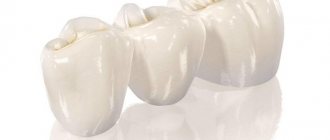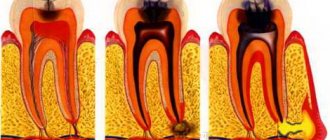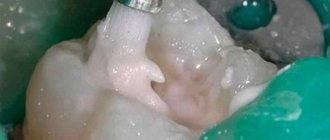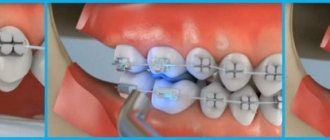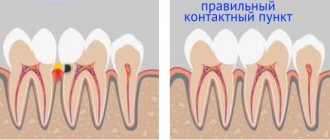Modern people do not visit the dentist as often as recommended. Usually a visit is associated with severe pain, when it is no longer possible to endure. Because of this, most patients are unaware of innovations in the world of medicine.
For many of us, a filling made of composite materials is the only option to plug a hole in a tooth. Few people know about the existence of ceramic and plastic fillings, not to mention advanced light fillings. Let's find out what a light filling is, the features of the most advanced fillings at the moment, and what their price consists of.
Features of installing light seals
An ordinary composite chemical filling, which is placed in any clinic, is distinguished by its affordable price and fragility. It hardens quickly as a result of mixing chemical components. There is no need to talk about the aesthetics of such a filling. It does not have a variety of colors and cannot be sanded in detail after installation.
The light filling hardens under the influence of ultraviolet radiation, until this moment the filling remains plastic . The dentist has no time limit to perfectly form a filling for a damaged tooth. Recreating the correct tooth shape is only possible with a light filling.
A photopolymer filling consists of a main filler and a substance susceptible to UV light. When exposed to ultraviolet radiation, two processes occur simultaneously: hardening of the filling and color polymerization.
The filling of the filling is chosen depending on the task at hand. For molars, whose main task is to chew food, fillers with large and coarse particles are intended. They don't look as nice, but they last longer.
For incisors (front teeth), aesthetics is much more important. These teeth come into contact with food only during a bite, so fillers with fine dust-like contents are intended for them.
Types of dental fillings
Dental fillings can be temporary or permanent. The first ones are installed only for a short period of time - for example, in the treatment of pulpitis or periodontitis, when a drug is placed inside the tooth. They are easily drilled and removed without damaging healthy tooth tissue. It is imperative to put permanent fillings in place of temporary ones - they fit more tightly to the tooth and allow you to completely restore its shape, aesthetics and functionality.
Dental filling materials
Some time ago, fillings were created from amalgam, cement, plastic or metal. However, today these materials do not at all meet the requirements for prosthetics: they are short-lived, not aesthetically pleasing, and amalgam is completely toxic. Therefore, today in dental practice completely different materials are used, which are distinguished by safety, long service life and aesthetics.
Light-curing composite fillings
Light-curing composites or “light fillings” are currently the most popular materials in dentistry: they are highly durable, hold their shape well even after long-term use, adhere tightly to dental tissues, and their color can be matched exactly to the shade of the enamel of a living tooth .
The filling material hardens only under the influence of ultraviolet radiation, so the filling can be formed over a long period of time, which is especially important when carrying out jewelry restorations of the front teeth. The service life of such fillings can reach 10-15 years.
In Moscow, very high quality composite materials produced in the USA, Germany and Japan are used. They are affordable, completely non-toxic, fully compatible with the body, behave consistently throughout their entire service life - they do not change shade, are resistant to abrasion, do not damage opposing teeth1 and have a minimal percentage of shrinkage.
Chemical composite fillings
Chemical composites harden on their own, so when installing them, the doctor performs a filling quite quickly - the material loses its plasticity. Such fillings are suitable for restoring lateral teeth, especially in the presence of volumetric damage, since the material has increased adhesion to the surface of the teeth. The shade of chemical composites does not fully correspond to the natural shades of enamel, therefore the material is not used to restore front teeth.
Glass ionomer cements
These materials have great advantages compared to conventional cement fillings. Among them are a longer service life, the absence of toxic substances, insignificant shrinkage and the presence of fluorine in the filling material, which has a strengthening effect on dental tissue. However, fillings of this type are more susceptible to mechanical stress and wear out more easily. That is why their use is more justified for strengthening a tooth, for example, before installing a crown or dental bridge.
How much does a light filling cost and why?
The cost of a light seal puts off many patients until they learn the real benefits of this approach. Prices for such fillings in different clinics range from 500 to 1000 rubles. But this is not the limit, because additional work is paid separately. As a result, the amount can grow to several thousand rubles for one filling.
What the patient pays for:
- Anesthesia if necessary (cheap or expensive, public clinics also offer free anesthesia)
- Removal of damaged tissue
- Cleaning the tooth before filling
- Polymer matrix
- Main filler (Silicon dioxide or glass ceramics)
- Binder
The clinic uses imported components for light fillings. The main suppliers are: USA, Japan and Germany. Analogues are being developed in Russia, but so far they are not on the market. The cost of the filling also depends on the country of origin. The quality of the composites is at a high level.
We advise you to find out in advance how much you will have to pay for each cycle of work. It’s better to choose a “turnkey” filling with anesthesia and x-rays for a certain price than to then quarrel with the administration and find out the reasons for the high bill.
What is the difference between a light filling and a simple one?
When a patient decides to have a tooth treated, he needs to make a choice whether to restore the tooth with a light filling or a regular one. To do this, you need to know how a light filling differs from a regular one.
Chemical curing (regular):
- small cavities;
- treatment of temporary and permanent teeth;
- will last from 1 to 5 years;
- differs from the natural color of teeth;
- materials may change color over time;
- affordable.
Light-curing filling:
- filling of the front group of teeth;
- large carious cavities;
- service life 3-7 years;
- thanks to the variety of shades, it is possible to select a color to match the surface being restored;
- the cost is higher due to the specialized staging system and the more expensive composite.
It is believed that a light-curing filling is better than a chemical filling and lasts longer. Also, if the doctor follows all the rules for placement and good cleaning of the oral cavity, a regular filling will last a long time and will prevent the appearance of secondary carious formations.
Stages of installing a seal
Installing a light seal is a lengthy process, but the result is worth it. The patient receives not just a patch for the tooth, he receives an almost new tooth with artificial filling. This step does not include pain relief because it is only used when necessary.
- First, the dentist examines the damaged tooth, removes damaged tissue, and disinfects the internal and external surfaces of the tooth. If necessary, grinds a hole to the required diameter
- Once all the preparatory work has been completed, the doctor dries the surface of the tooth so that saliva does not remain under the layers of the filling.
- A light-sensitive polymer is placed into the resulting cavity layer by layer. Each layer is dried until hardened, after which a new one is applied
- The very last top layer requires special attention. The dentist’s task is to recreate the surface in such a way that the tooth is reconstructed to its original state
- Before exposing the final layer to ultraviolet light, the dentist checks the interaction of the tooth with the opposing teeth. The bite should not change
- After the filling has hardened under exposure to light, it is ground and polished to resemble a natural tooth.
- The final stage will be an x-ray of the tooth to make sure there is no air and moisture in the dental cavity. Typically, this service is paid additionally
Light fillings on front teeth
When it comes to the aesthetics of the oral cavity, all dentists recommend installing a light filling. No other is able to fit into the dentition in such a way that there are no differences.
The light-curing filling has a large number of colors and shades. Once you have decided to have it placed, your dentist will select the shade of the filling based on the color of your tooth. This is a critical moment for the front teeth. The boundaries of the light seal are almost impossible to see.
How to install a light seal
Dental treatment involves removing infected tissue (dentine, pulp), cleaning and sealing root canals. The restoration itself takes place directly in the oral cavity:
- The patient's eyes are protected from ultraviolet radiation by glasses
- the doctor selects the shade of the composite
- Apply it layer by layer to the tooth
- each layer is treated for 20 seconds with a special UV lamp
- polishes the filling, achieving perfect closure of the teeth
- polishes the surface to a natural shine
Advantages and disadvantages
There is nothing better than a natural healthy tooth. Therefore, any dental intervention will have its pros and cons. A light filling certainly has more advantages.
Advantages
- High plasticity of the filling for an unlimited time, which makes it ideal. The material will not harden at the most inopportune moment
- Safety for the patient, no side effects. The filling can be placed on children and pregnant women. No toxins
- A large color palette from which the doctor can select a color that is indistinguishable from the natural tooth of each individual person
- Durability
- A correctly formed filling does not cause any discomfort to the wearer.
- A light-curing filling can restore a tooth, even if more than half of the bone tissue is destroyed
- Almost instant bonding with the tooth. After an hour you can already consume food in most cases
Flaws
- The first and main disadvantage is the high cost. Of course, it is not formed out of thin air; you will definitely be pleased with the result. But a fact is a fact
- The light seal cannot be placed in hard-to-reach places. Such fillings do not cover external cervical caries of “sevens” and “eights,” for example. Because the ultraviolet lamp will not be able to illuminate the surface of the tooth, and the filling will not harden properly
- For several days, you should not consume food or drinks that are coloring, so that the filling does not change its color.
- Over time, the color may change and move away from ideal similarity due to incomplete polymerization
What is a light filling and when does it become necessary to place it on a tooth?
What is a light filling and why do dentists recommend placing it on a tooth when treating caries? Light (photopolymer, light-curing) filling is what ordinary people far from medicine call a filling material that hardens only under the influence of ultraviolet radiation. The hardening process of light fillings occurs quickly - in just 40-60 seconds and to start it, the dentist will use a special UV lamp.
THIS IS INTERESTING: The speed of hardening of light fillings is one of their advantages. They harden under the influence of ultraviolet light in less than a minute and acquire high strength. Chemical filling composites take about 2 hours to harden.
Light fillings can be placed on teeth both for the restoration of chewing units and for high-quality restoration of teeth included in the smile zone. This type of filling material is highly durable, aesthetically pleasing, and has a wide range of shades, which allows you to select and place a light filling exactly to match the natural enamel of the patient’s teeth.
Indications for the use of light fillings are as follows:
— Treatment of caries, pulpitis, periodontitis of teeth.
During the treatment process, the dentist will drill out the tooth and remove all tissue destroyed by caries. As a result, a cavity is formed that needs to be closed both to prevent bacteria from entering the internal tissues of the tooth and to return the tooth to all its functions and attractive appearance; — You can also put a light filling on a tooth if the enamel is chipped, if part of the tooth breaks off due to a minor injury;
— In some cases, aesthetic restoration of teeth is carried out using light fillings. For example, if the tooth enamel has become very dark and cannot be whitened using professional whitening techniques.
But you should know that the decision to put a light filling on a tooth will not always be the right one - if your tooth is destroyed by more than 50%, it is better to restore it with an inlay or a crown. Light fillings have high strength, but with such tooth destruction they may not withstand constant and heavy load.
How long after a light filling can I eat?
Dentists recommend not eating for exactly one hour after you leave the office with a new tooth. Much depends on what size filling is installed and what percentage of the tooth was initially damaged.
- If a filling is placed in a tooth with a small hole, that is, it can be done immediately after installation, there are no restrictions. True, such situations rarely happen.
- If the tooth damage was moderate, then it will be enough to refuse food for an hour
- If the tooth has been restored, if there is now more filling material on it than bone tissue, then refrain from eating for 2-3 hours. After three hours of waiting, you can definitely eat no matter how much dental work you do.
How long does the filling last after installation?
Light seals have a lifespan of 5 years. Much depends on oral care and nutrition. With proper care, a filling can last more than 10 years. There are certain recommendations for extending service life:
- Maintain daily oral hygiene. Good brushing of teeth in the morning and evening, mouthwash and floss throughout the day. Your dentist can recommend a toothpaste to you based on the condition of your mouth and the sensitivity of your teeth and gums.
- Stop smoking. It greatly reduces the service life. A polymer filling has high strength, but a natural tooth does not. By destroying the natural foundation for the filling, you destroy the filling itself.
- Try to avoid sudden changes in temperature in the oral cavity. Do not drink hot soup with ice water, as this will cause microcracks in your teeth. Because of this, the structure of the restored tooth is disrupted, the filling may lose contact with the tissue and fall out
- Eat more solid foods, especially fruits. Contrary to misconceptions, hard food does not cause any harm to enamel and fillings, unless you chew bones, of course. One apple can provide additional teeth cleaning throughout the day
Features of the composition of a light-curing filling
Photopolymer materials (composites) used in the manufacture of fillings consist of two main components: a bulk filler and a light-curing polymer. These materials can be varied, their use depends on a number of factors: the location of the filling on the tooth, the intended purpose of the filling and the aesthetic preferences of the patient.
Types of fillers for light-curing fillings:
- Macrofillers are the main component of most popular photopolymer fillings. They have high strength and good radiopacity, allowing the doctor to evaluate the quality of work after the procedure (which is especially important in the process of filling canals). They have a fairly rough, rough structure and are subject to slight pigmentation, therefore they are used for filling chewing molars and other non-facade teeth;
- Microfillers – have a finely dispersed structure that increases the overall aesthetic appeal of the filling material. This filler has a uniform, stable color, practically does not undergo pigmentation and acquires a specific shine to tooth enamel after polishing. Used for filling anterior teeth where aesthetics play a critical role;
- Minifillers are a universal solution that combines the properties of macro and microfillers. Due to the lack of pronounced advantages, they are used quite rarely, as a rule, for filling small defects. The key disadvantage of fillings with mini-fillers is the difficulty of processing and polishing, with average resistance to mechanical loads.
- Nanohybrid fillers are the most modern and expensive material. It has a whole range of advantages over traditional solutions and has good plasticity, increasing the comfort of use in hard-to-reach places in the oral cavity. It also does not stick to the instrument and is used for the restoration of teeth with varying degrees of damage;
The choice of material for installing a light-curing filling is made by the doctor, based on the data of the initial examination, the characteristics of the tooth being filled, the size and complexity of the carious cavity, as well as the individual preferences of the patient.
conclusions
A photopolymer filling is the most perfect way to restore a damaged tooth to almost its original condition. Durability, lack of side effects and restrictions have made this technology popular all over the world. Reviews about such fillings are the most positive.
Such fillings cost several times more than chemical ones, if only because all the components are imported from abroad. But if you consider how long light seals last, then you can and should come to terms with the prices.
Choose a high-quality clinic, find out exactly how much and what you are paying for, and do not forget to take care of your teeth so that the filling serves you much longer than its intended period.



